Home > Articles > Special Series > Bluegrass Banjo Players honor Bill Emerson
Bluegrass Banjo Players honor Bill Emerson
As most bluegrass music fans will know by now, legendary bluegrass banjo player—and Bluegrass Hall of Fame member—Bill Emerson passed away in August of 2021. In order to honor Bill’s tremendous contribution to bluegrass music—starting in the mid-1950s and continuing through the date of his passing—we will be featuring a series of special web-based articles covering all of the various important periods of Bill’s long and distinguished career. The article series will proceed chronologically, starting back when Bill first learned how to play the banjo and continuing through the early years with Buzz Busby, the Country Gentleman, Jimmy Martin, Emerson and Waldron, Country Current, and his post-Navy career with his own band Sweet Dixie.
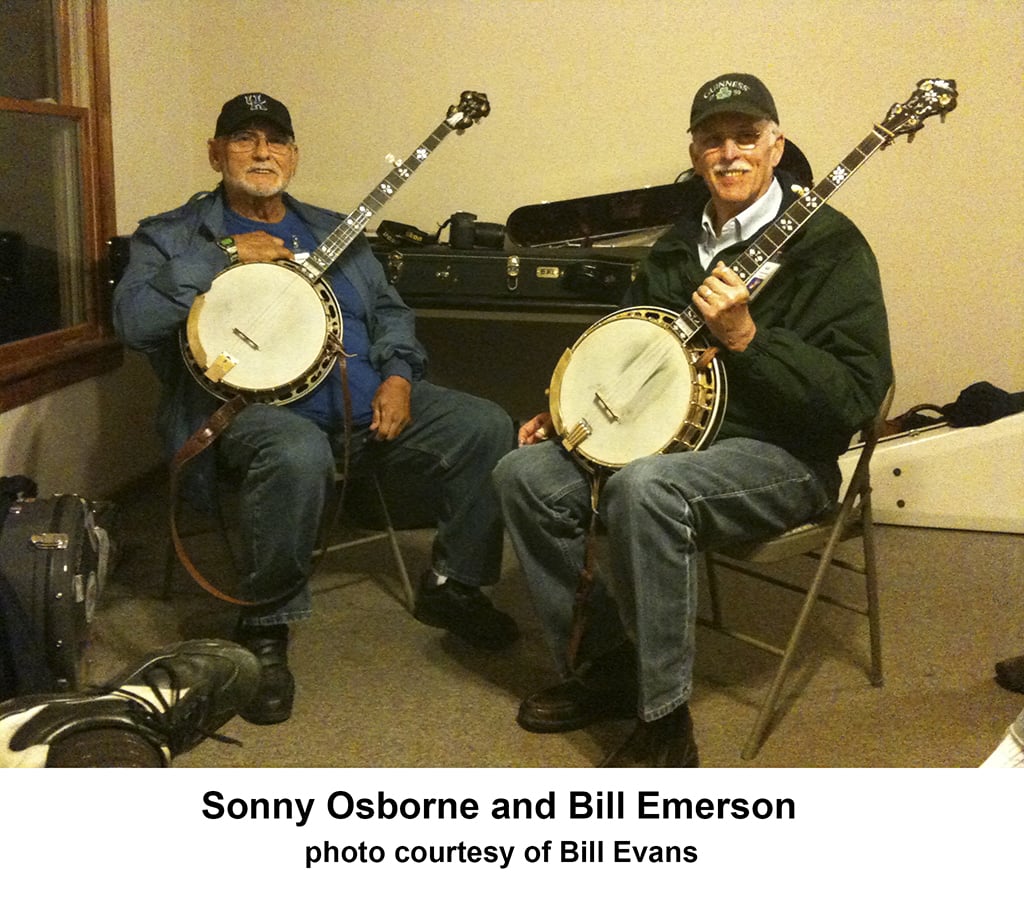
In addition to his performing and recording career, Bill was also involved in the founding of Bluegrass Unlimited Magazine in 1966 and was an active contributor in our early years. With a career in bluegrass that lasted over sixty years, we feel that a single article in the print magazine would not be sufficient to address all of Bill’s influence and accomplishments. In this web-based article series we will be able to include much more about Bill’s career so that all bluegrass fans can discover how much Bill influenced the music during those decades that he spent playing, writing, and singing bluegrass music.
As an introduction to this article series, I felt like it would be nice to hear from some of the banjo players who have been influenced by Bill as a musician and as a person. With this introduction, you will discover how Bill’s contributions to bluegrass were felt by those who knew him. In the next article we will begin to present the details of Bill’s long career. For this week, here are the words that some prominent bluegrass banjo players have contributed regarding their relationship with Bill and the influence he had on them.
Pete Wernick:
Bill Emerson has always been a “model banjo player” to me. Like Scruggs or Crowe, never an unclear note, always smooth, solid timing, great melodic sense, and tasteful to a fault. His tone didn’t lean toward trebly or bassy—just full and rich covering the whole spectrum any time you’d hear him, on whatever banjo he was playing.
Sometimes when I practice, I stop and think, “How would Bill Emerson make this sound,” and that simple thought helps focus my playing on “the sound that made me want to play banjo.” Precision, clarity, mastery and just plain “all-good sound”—that was his hallmark. The creativity he brought to the music was never bizarre or “challenging,” but would offer new and different touches, more an expansion of “standard bluegrass vocabulary” than an alternative to it.
As a person, the word “gentleman” was often used to describe him—carrying himself with the quiet dignity one would expect from a naval officer (which he was). This even showed when he took a turn at writing, in long-ago BU articles describing his time as one of Jimmy Martin’s Sunny Mt. Boys. He was able to convey Jimmy’s idiosyncrasies clearly enough while maintaining his characteristic “good tone” and respect for his mentor.
On stage or off, Bill was truly a class act. He’s left behind a bountiful legacy of recordings spanning seven decades, and many memories of being a revered and graceful legend in the bluegrass community. We will miss you, Bill!
Alan Munde:
Bill Emerson, from his very first recordings to the last, was the epitome of smooth, graceful, clean, meticulous, highly musical bluegrass banjo playing. I worked in the band led by Jimmy Martin (October, 1969 to October, 1971). During that time as I tried my best to play in the Jimmy Martin way, Jimmy would encourage me to develop my playing to fit somewhere between J. D. Crowe and Bill Emerson, the two favorite players that worked and recorded with him.
Bill Emerson demonstrated to me the beauty in the artfulness of the roll approach that is the core of bluegrass music—to have faith in the style, the roll. The music he made was endlessly interesting and accessible, a winning combination in our world.
While touring with Jimmy, we would cross paths with the Country Gentlemen, who Emerson was working with during those days. Bill would always take a moment to say hello and offer words of encouragement, and in passing share a few of his experiences with Jimmy. It gave me comfort to know that I was not alone in my Jimmy Martin schooling. What really felt good and was helpful to me was that he treated me as a colleague and fellow professional, although I saw myself as a novice in the grown-up bluegrass world.
I saw Bill many times over the years, and then for the last time at an event at the Bluegrass Museum in Owensboro, Kentucky in 2019. He was the same gentleman to me each and every time as he was when we first met. Bless your heart Bill Emerson.
Carl Jackson:
I have very vivid and wonderful memories of Bill from his days with the Country Gentlemen. I was just a kid playing banjo with Jim & Jesse and I remember how kind he was to me in those early years. If we were at a festival together, I always looked forward to watching Bill with the Gentlemen and learning from his distinct style… a banjo giant.
Marc Pruett:
Bill Emerson was a huge influence on me. His playing was clean, powerful, and innovative in his own way. He combined Scruggs’s style with all kinds of runs and “hot” licks that truly identified his playing as unique. His kick off to “Down By the Waterfall” was just captivating…subtle…and intuitive.
Bill gave the special touch of his style to every song he played… “Two Little Boys,” “Matterhorn,” “Fox on the Run.” I saw him play “Sally Goodin” in the key of “B” with the Gents at Randy’s Pickin’ Parlor in Nashville one time. It was stunning. Bill knew when and how to focus dynamics and power. Tony Rice once told me that when he recorded with Bill, “He makes you stay with him, and he stays in the right place.”
When Bill was with the Navy band, Steve Sutton and I visited with him in Asheville once. Steve and I were “eat up” to hear Jimmy Martin stories. In my best recollection, here’s one in Bill’s voice:
“When Jimmy first hired me, he drove his Cadillac to Virginia to pick me up and go back to Nashville. We started going back toward Tennessee through the Blue Ridge Mountains, and we were having a great talk about music. We came around a curve, and there sat a big ground hog in the grass by the road. Jimmy saw that ground hog, and it was like he became a possessed person. He yanked that Cadillac off the road, flung open the door, and started running after that ground hog. He chased it down into some rocks and bludgeoned it to death with a tree limb he’d picked up.
“The funny part was…when he saw that ground hog, he was so anxious to get out of his Cadillac and go after it, he didn’t put the automatic transmission into park. There I was in the passenger’s seat, Jimmy chasing a ground hog down the hill, and the car was rolling off. It was all I could do to scoot over, hit the brake, and throw the car into park before it hit something.
“Jimmy came back up the hill swinging that bloody ground hog by the tail. He opened the trunk and just threw it in. When we got off that mountain, Jimmy stopped at a gas station and tried to trade that dead ground hog to an old black man for some gas! That was my introduction to life with Jimmy Martin.”
On Bill’s time with Jimmy Martin…not only did he record some classics, he was a contributor to that band’s creativity. They recorded new songs that had great banjo-mandolin twin parts, songs that stretched the boundaries of what Jimmy had done, and Bill put his powerful influence on song after song with his great banjo playing.
Bill Evans:
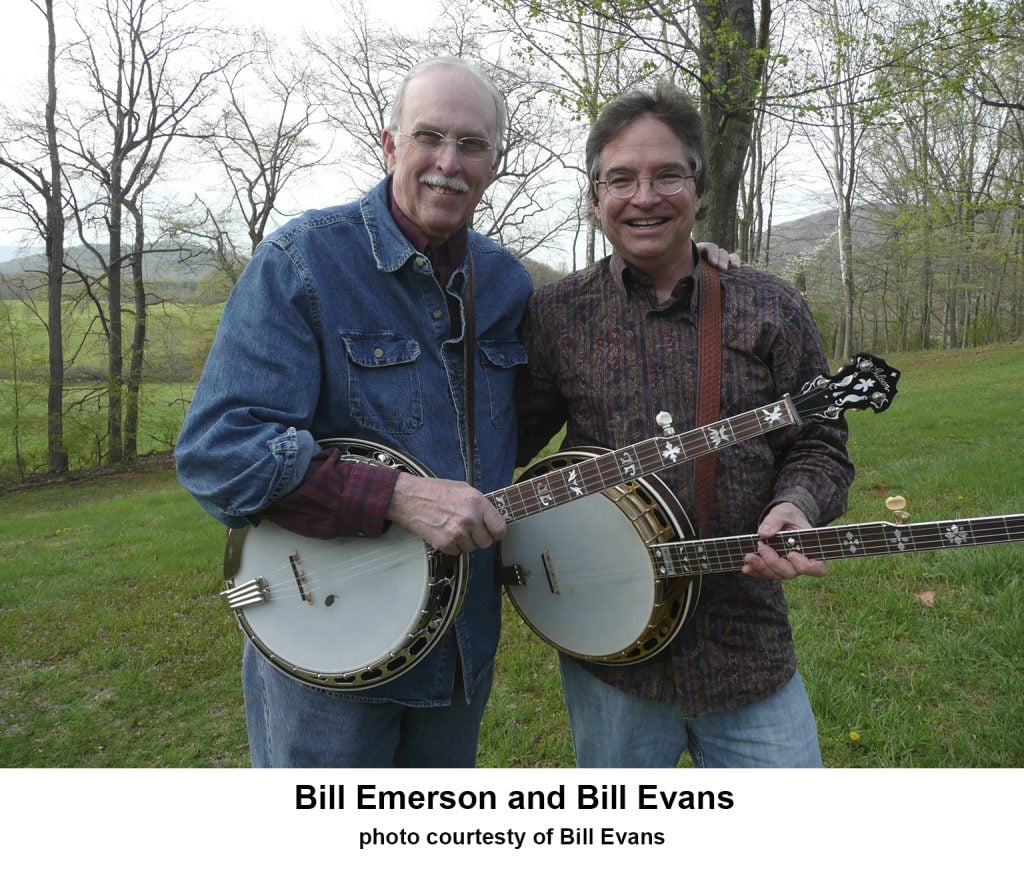
I got to know Bill when mutual friend Sonny Osborne talked him into coming to the Nashville area to be a part of two of our NashCamp Sonny Osborne Banjo Camps around ten years ago. Sonny was able to convince a lot of players into coming who didn’t usually teach at events like this (because he was Sonny Osborne) and I wanted to try my best to make Bill feel comfortable and confident throughout our weekends together. That turned out to be an easy job and Bill was the one to put me at ease as a camp co-director. I learned that he was a great observer and listener and, along with his easy-going personality, these were the ingredients that also made him a wonderful teacher.
Bill and Sonny traded stories, both in our public workshops but also privately, and the more that they talked (often about Jimmy Martin), I started to think about how special and unique these long-term relationships are among bluegrass musicians. This particular friendship between these two banjo icons went back to the 1950’s and through many different phases of the history of bluegrass music. I was humbled by how much these men had experienced in their lives, how much they shared and how much great banjo music they had created.
Bill has written more original banjo compositions that are commonly played in bluegrass jam sessions than any other player – including Earl Scruggs. Think about that for a minute. There’s “Theme Time,” “Cowboys and Indians” and “Sweet Dixie.” And there’s tunes like “Welcome to New York” and “Home of the Red Fox,” that are played by contemporary musicians such as the Infamous Stringdusters and Billy Strings. Kristin Scott Benson has included a Bill Emerson original that Bill wrote especially for her on each of her solo recordings. Why do Bill’s tunes work so well? It’s because they lay out so well on the instrument but yet each tune is unique and explores something new on the banjo, whether it’s pull-offs, passing chords or how more complex chord progressions can gracefully and creatively lay out on the instrument.
At one camp, Sonny suggested to Bill and me that we record an instrumental version of Bill’s tune “Sweet Dixie” and “Home Sweet Home.” Not as a medley – but playing both tunes at the same time! Bill and I traded skeptical looks and I knew that he was thinking the same thing as I was thinking: “Okay, these songs have the same chord progression but won’t this sound like just a bunch of noise? Well…this is Sonny Osborne who is suggesting this, so what are we to do?”
Of course, Sonny’s idea was a great one and we did record this “medley,” calling it “Home Sweet Dixie Home” and it’s included on the project “A Touch of Time” by Bill Emerson & Sweet Dixie. I was especially proud of the harmony banjo parts we worked out for “Sweet Dixie” in the middle of tune. As we were tracking it, I realized how much I had internalized Bill’s rhythmic feel from decades of listening to his recordings and how deep of an influence he was on my playing.
Some describe Bill as a quiet or reserved person, but I think of him more as someone who was thoughtful in all things—careful to be supportive of others, always listening, always encouraging. I treasure the time I was able to spend with him.
Murphy Henry:
Bill Emerson had a tremendous effect on my playing because some of the first “live” banjo playing I heard–while I was still a bluegrass newbie–was from the hands of a young banjo player who worshipped Emerson and tried to play just like him. So the first banjo sounds that I absorbed included the essential elements of Emerson’s style–tone, taste, and timing—and a sound that was clean, crisp, and uncluttered. His pull-offs (3 to 2 on the third string) were to die for and I spent many happy hours trying to emulate them.
In the early 1970s, when I started learning banjo, the melodic style was all the rage. But even as a novice, I knew that style wasn’t for me. In that era, the playing of Bill Emerson, then with the Country Gentlemen, stood out like a beacon from a lighthouse. And as the gospel song says, “I thank God for the lighthouse!” So while other young banjo players were learning “Lonesome Fiddle Blues,” from the groundbreaking New Grass Revival album, I was learning “Breaking It Down” from The Award Winning Country Gentlemen. I heard that song so many times that my fingers found those “walking down” notes of their own accord. Later when I finally got to meet Bill, I found his personality matched his playing: straightforward, strong, and dignified. I didn’t know him well but I was proud to call him a friend.
Gena Britt:
I have been a fan of Bill Emerson’s banjo playing since I was a little girl. The Home of the Red Fox album was the quintessential album, in my opinion, for tasteful, forward-thinking banjo playing. Some of the first tunes I remember wanting to learn how to play were “Cowboys & Indians,” “Sweet Dixie” and “Welcome to New York.” Those songs were exciting and made me want to step outside the box and be more creative in my playing. I think everyone from my generation feels the same way & will always remember Bill for his contributions to our music and his amazing banjo playing & compositions.
Scott Vestal:
The first time I remember hearing Bill was with the Country Gentlemen. I loved his smooth, clean style so much that I tried to emulate his playing with the bands I was in. Years later when working with Doyle Lawson, Doyle would tell us stories of when they worked together and that he had almost joined the Navy when Bill did. I later got to meet Bill in Owensboro, KY backstage at the IBMA festival. He was such a genuinely nice man and easy to talk to, and very funny. We recently recorded one of his and Doyle’s tunes , “Welcome to NY,” on our Bluegrass 2022 project. RIP Bill Emerson. You will be greatly missed!
Kristin Scott-Benson:
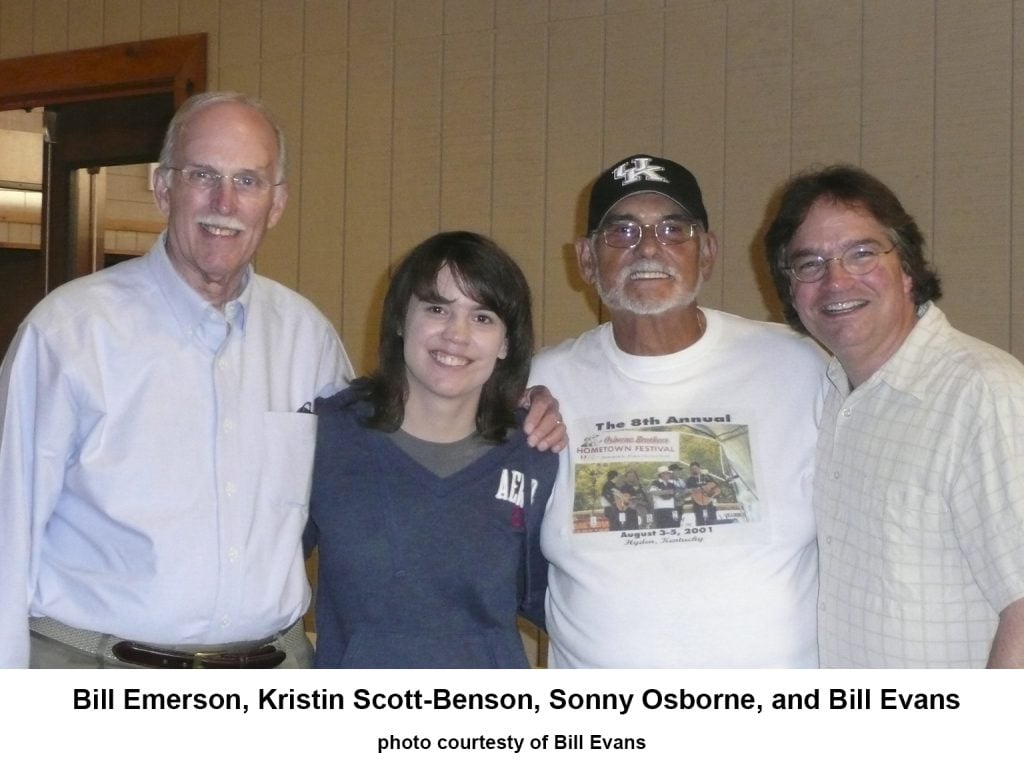
Bill was one of my biggest influences. I played with his album, Home of the Red Fox, countless hours as a teenager. He had a knack for writing banjo songs that had real melodies with hooks that drew you in. While that may not sound overly impressive, it is; so many banjo tunes are basically licks strung together. He had a long career and I enjoy hearing him play in all the different contexts. He was a true gentleman and friend to me. I’ll miss him.
Mike Scott:
I first met Bill Emerson June 1973 at the Slagle’s Pasture Bluegrass Festival in Elizabethton, TN near my hometown of Watauga in East Tennessee. Bill was performing with The Country Gentleman….Charlie Waller, Doyle Lawson, & Bill Yates. I remember him being such a “gentleman” and I loved his banjo playing. After my introduction to Bill and watching him play, I started listening to the recordings he played on with The Country Gentleman, Jimmy Martin, etc. I was intrigued by his solid right hand, timing, and the tone that he played. I had been playing banjo for a little over a year at that time and was personally touring the five-state area at major bluegrass festivals where I would see Bill occasionally at various shows thereafter.
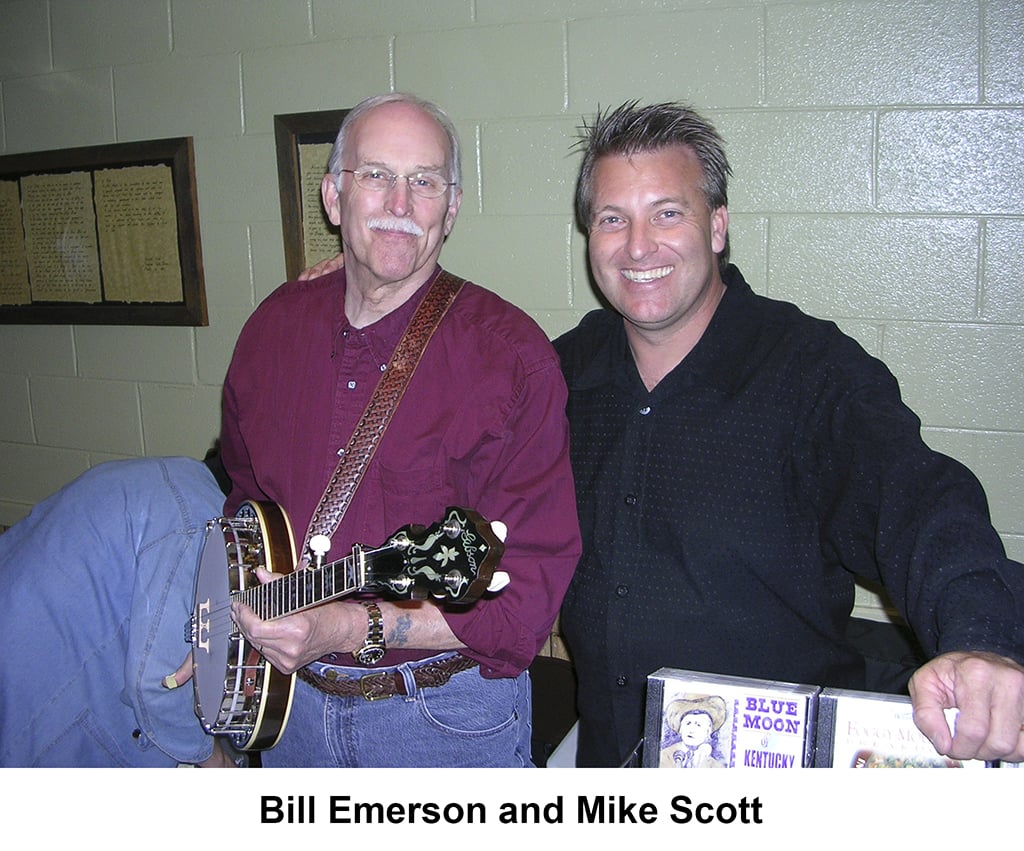
On a later occasion, while I was a Junior at Happy Valley High School in 1979…we were having a country/bluegrass band performing at our school on that upcoming Friday. I had no clue who it was. Since I was in cabinet making class…our shop teacher volunteered our class to help the band unload and set up. I remember when I walked up to their bus, it was then I realized that The Country Current Navy Band was performing. About that time, none-other than my “Banjo Buddy” Bill Emerson… stepped off the bus. He looked at me and said… “Well, hello there Mike Scott! Great seeing ya! Well… I had no clue you went to high school here. Wait a minute…here….carry my banjo to the gym and on stage for me.” I was so excited to be able to visit with Bill and enjoy the band as they performed… and of course getting to carry his banjo. He let me play for him & my classmates before the show started. Just happen to have my picks. I carried them daily to school and everywhere. After the show at my high school, we all helped tear down and helped them load their bus. Before they pulled out, Bill invited me to a show he was playing that evening while he was in town at The Down Home Pickin’ Parlor in Johnson City, TN. So glad he put me on his guest list.
Another great memory.
From the years that followed later, I was honored to know Bill and see him occasionally as well as call him a friend and “Banjo Buddy!” I have enjoyed teaching along side him at various banjo workshops as well as the occasional bluegrass shows and will always cherish the time we got to visit… and that was time well spent. I was saddened to hear of his passing August 21st, 2021. Bill will always be a “Banjo Hero” of mine!
Joe Mullins:
Some of my all-time favorite recordings feature Bill Emerson on banjo.
Jimmy Martin “Tennessee,” “Prayer Bells of Heaven”; Country Gentlemen- “Paradise,” “Legend of the Rebel Soldier,” and “Little Bessie.”
We could write an entire article just on Big Bill’s pull and tone on “Little Bessie!” His controlled power delivered precision—think about that. Out of control power can get ugly. But with just the right control and touch, harnessed power becomes a thing of beauty. Like a great athlete or well-engineered automobile.
Bill Emerson was also a great leader and an encourager. Being present at his Bluegrass Hall of Fame induction was so special to me. His brilliance as an artist was so worthy and will always be remembered.
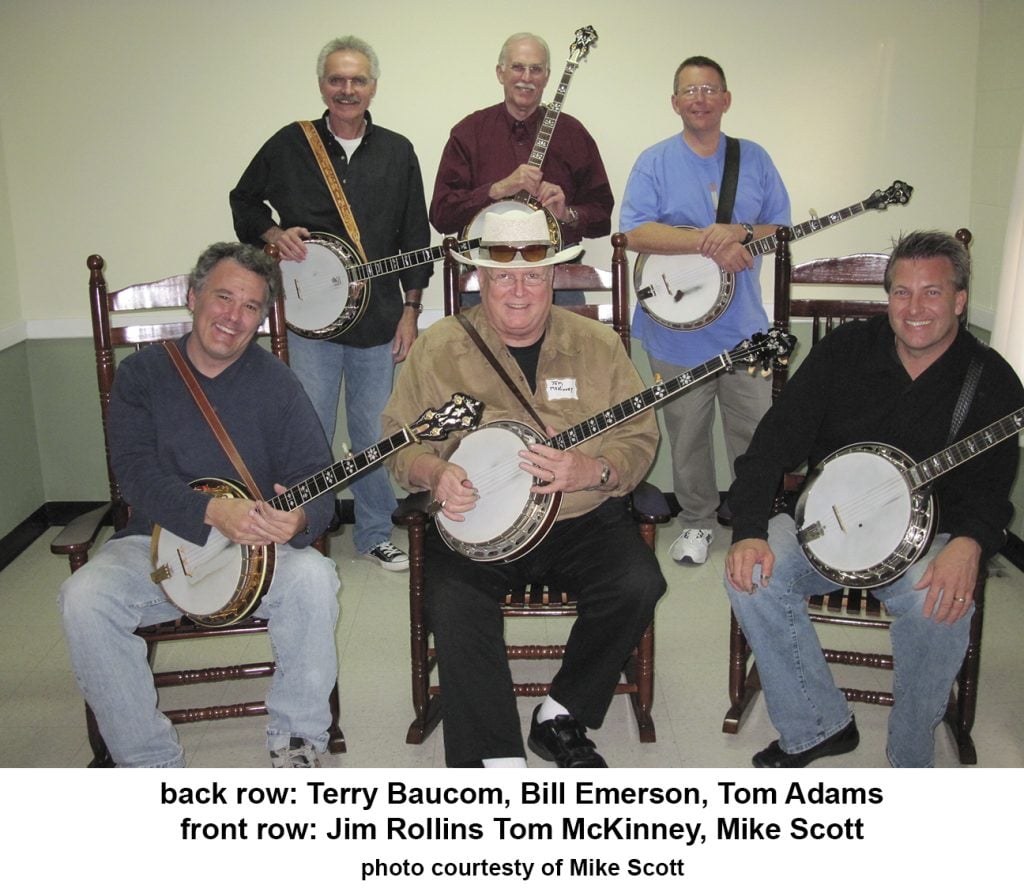
Tom Adams:
Bill’s recordings with Jimmy Martin and the Country Gentlemen were right at the top of my daily practice routine when I was learning to play. I can’t tell you how many times I played along with “Little Bessie” trying to get the feel of Bill’s roll. And his break on the Emerson & Waldron “Proud Mary”—the synchronicity of the left and right hands—that was what I wanted to be able to do. Bill’s playing, his kindness and encouragement to up-and-coming players was tremendously inspirational.
Share this article
1 Comments
Leave a Comment Cancel Reply
This site uses Akismet to reduce spam. Learn how your comment data is processed.
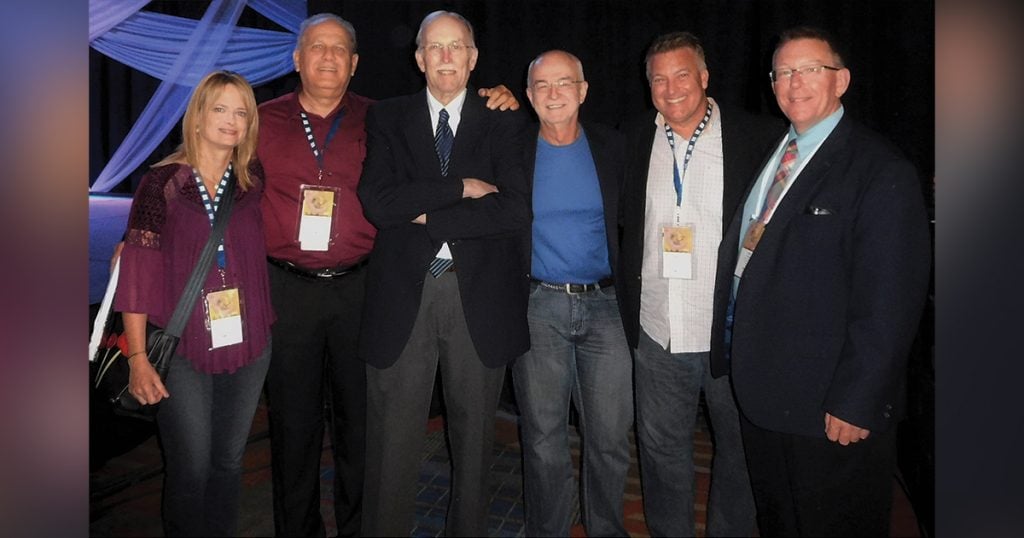
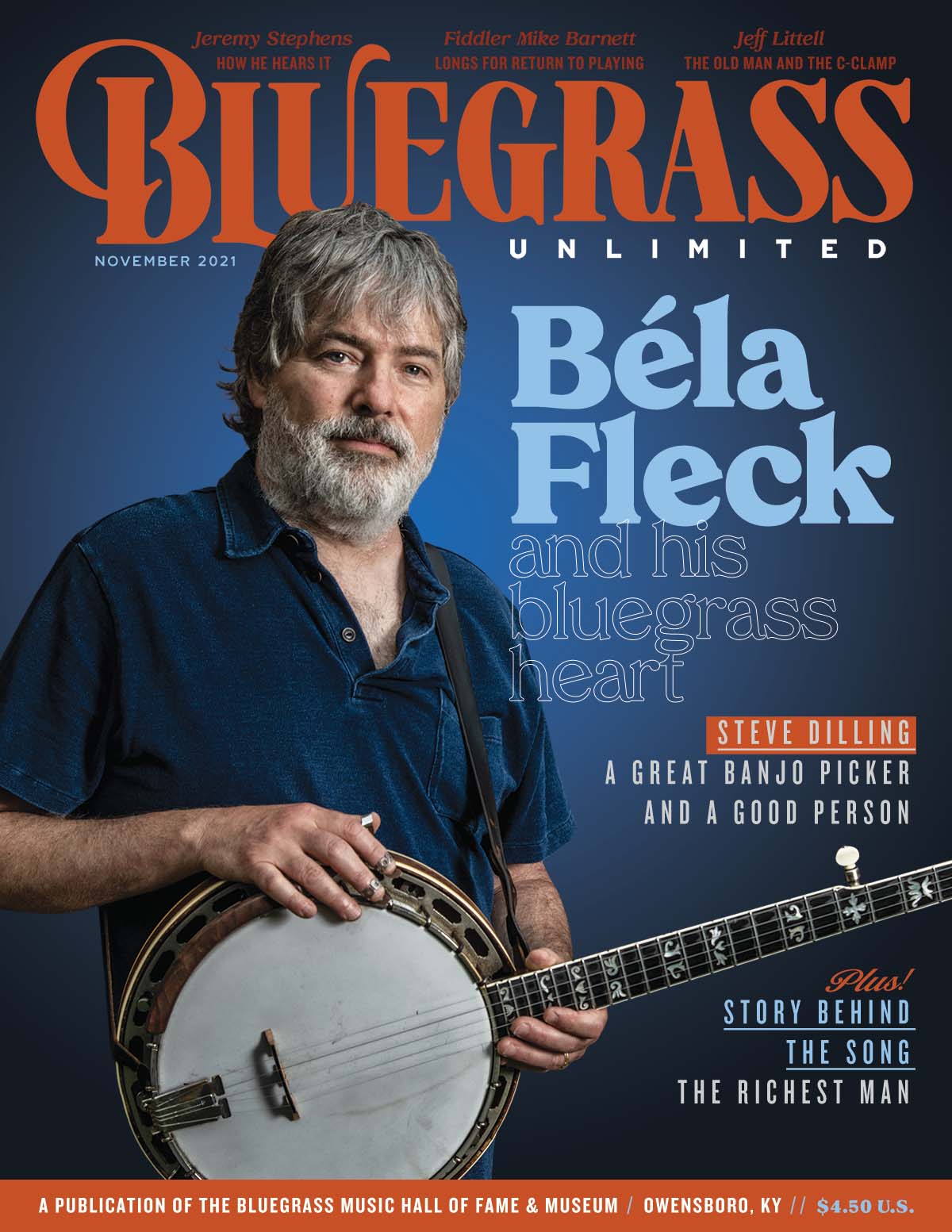
Country Gentlemen Festival 1972 Photos
https://frobbi.org/images/favorites/BillEmerson-CountryGentlemen1972-FredRobbins.JPG